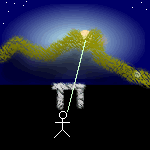
Heaven on Earth, joining the realms together
| Pre-Dawn Star Gazing |
| Framework of Time |
| Heaven on Earth |
| Planets, the wanderers |
| Catastrophe! Precession |
| It's Written in the Stars |
| About this Site |
| Resources |
| Feedback Form |
| Index |

|
| Binding Earth and Sky | |
|---|---|
|
To keep close watch on what was happening in the sky, to
know the exact dates of solstices and equinoxes, people
used observatories. Some natural, some they made.
Points on the horizon, such as mountain peaks, line up exactly with the rising or setting of the sun &/or moon on special days, if you've picked the right spot to watch from. This spot might be naturally marked by some landscape feature, or markers could be erected of wood or stone or the earth hollowed or mounded for this purpose. People in many parts of the world built huge stone monuments, including standing stones, earthworks, pyramids. Stonehenge being just one of the better known sites. Some sites such as Newgrange are actually dark enclosed mounds oriented so that only the winter solstice sunrise illuminates the marker in the chamber. Symbolically perhaps, the sun's light penetrates a womb-like chamber in the earth, heralding the promise that winter will end and spring return. Although solstice marking alignments are the most well known, some monuments have been shown to have alignments to the equinoxes and / or cross-quarter days. Several of these are discussed in "Stones of Time". Not all of the monuments are observatories. Many of these are earthly reflections of celestial locations. The pyramids at Giza are arranged like the stars in Orion's belt. Around Glastonbury are a collection of earthworks that correspond to the zodiac. |
